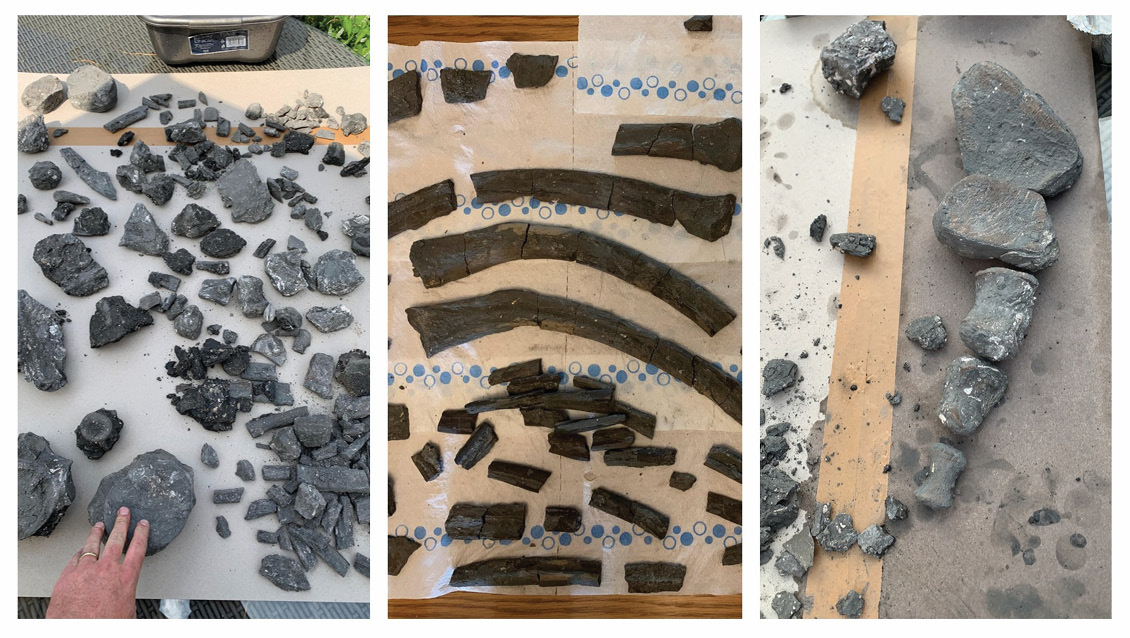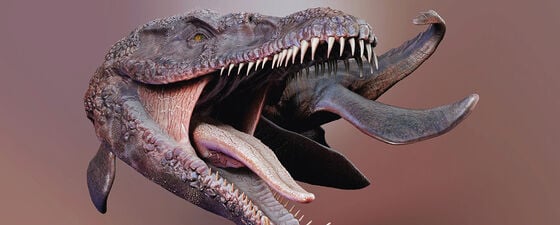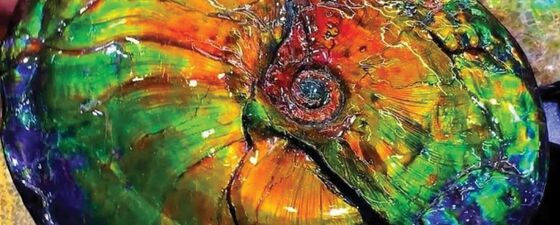You could be forgiven for thinking Mary was the first to discover ichthyosaur and plesiosaur fossils, but specimens of ichthyosaur vertebrae and propodial (limb) bones and pliosaur vertebral centra were in the Ashmolean Museum in Oxford over 100 years before Mary was born, as illustrated in Edward Lhwyd’s 1699 contribution Lithophylacii Britannici Ichnographia, published during his tenure as Keeper of the collection. Some of those illustrated specimens came from localities within reasonable walking distance of where I live, an area where the Tithonian part of the Kimmeridge Clay has yielded abundant ichthyosaur, plesiosaur and pliosaur remains, crocodylomorphs (thalattosuchians), turtle, fish, shark and even dinosaur fossils! While isolated bones had been collected during the 1600s (and quite probably earlier), their significance wasn’t really recognised until more complete skeletons started to be unearthed in the early 1800s. The Temnodontosaurus skull and torso discovered by Joseph and Mary Anning rocked the world even though fairly complete skeletal material had already been collected elsewhere in the UK and Europe. Stunning specimens of ichthyosaurs continue to be collected to this day on the Jurassic Coast, often turning up in the workshop of Christopher Moore (Figure 1).

The ‘Fish Lizards’
Appearing in the Triassic, and surviving most of the Mesozoic, ichthyosaurs were cosmopolitan, with fossils recorded all over the world, from the Berlin-Ichthyosaur State Park in Nevada USA to the Eromanga Basin in Australia. Complete skeletons are not uncommon, so their anatomy is well-understood, but the taxonomy is a bit of a mess and is currently being overhauled by the academic community. A lot of genera and species level designations were introduced (particularly by early workers) on insubstantive material such as isolated vertebral centra which may not be sufficiently diagnostic for species recognition (e.g., Figure 2).

Ichthyosaurs (named after the Greek words for fish and lizard) ranged in size from small taxa, typically a few feet in length, to enormous beasts such as Temnodontosaurus – a fearsome-looking animal with the largest eyes recorded for any organism that ever lived on Earth. In exceptional cases, their eyes could literally be the size of footballs, although they weren’t perfectly spherical in shape. Temnodontosaurus also had one of the greatest bite forces ever calculated – what a predator!
Some exceptional specimens are preserved that tell us a lot more about ichthyosaurs (notably from localities like Holzmaden in Germany, and Dorset and Yorkshire in the UK). From fossilised skin we know that some were counter-shaded like sharks (dark on the back with a lighter underbelly), they had blubber, they carried embryos and gave birth to live young and fed on a diet of fish and squid (belemnites) and occasionally even ate each other, as evidenced from coprolites containing ichthyosaur teeth and vertebrae (Figure 3).

Monsters of the Deep
Ichthyosaurs weren’t the only large marine reptiles comprising the upper echelons of the food chain. Plesiosaurians (plesiosaurs, pliosaurs) also arose during the Triassic, living throughout the Mesozoic before extinction of the elasmosaurs at the K–T boundary (this boundary marks the end of the Mesozoic Era, and the beginning of the Cenozoic Era, and is associated with the Cretaceous–Tertiary mass extinction event).
Unlike the ichthyosaurs, complete skeletons of Jurassic plesiosaurs (long-necked, small skulls) and pliosaurs (short-necked, large skulls) are far less common. Many taxa are based on bones from the torso, limbs and paddles, or from teeth, mandibles or skull material. It is unusual to find very complete specimens.
Plesiosaurs have gripped the imagination of the general public for 200 years, from the discoveries of Mary Anning in the early 1800s, to the legend of ‘Nessie’ the Loch Ness monster, often portrayed as a plesiosaur. Some iconic pictures of Nessie (including the ‘surgeons photograph’) are now widely recognised as hoaxes.
More recently, documentary coverage of some enormous Pliosaur skeletons have recaptured the attention of the general public, with specimens collected from the upper Agardhfjellet Formation in Svalbard being dubbed ‘The Monster’ and ‘Predator X’ (now formally described as Pliosaurus funkei; Figure 4), and from Mexico, the ‘Monster of Aramberri’ from the broadly age-equivalent La Casita Formation. Realistic estimates place these specimens in the range of 13–15 metres in length.

Other very large pliosaurs include the >2m skull of the Weymouth Bay Pliosaurus kevani thought to have had the bite force to crush a small car, and of course the iconic Liopleurodon ferox. Both P. funkei and P. kevani are named after the original finders of the specimens. The reality of most of these large finds is that they can take many years, a lot of dedication, and sometimes a large team to retrieve the specimen. It is common for skeletons to be gradually exposed, often in hundreds or even thousands of pieces (e.g., Figure 5). In the case of Predator X, the skeleton is thought to comprise an incredible 20,000 pieces! The Svalbard locality has yielded material from around another 40 plesiosaurian skeletons – a very important site which will no doubt yield some more sensational fossils.

Like the ichthyosaurs, plesiosaurians had a taste for squid (belemnites) and fish but have also been found with other marine reptile and even dinosaur remains in their stomach contents. Assemblages of marine reptile bones from the Kimmeridge Clay and its equivalents typically show extensive predation and scavenger bitemarks on bones (e.g., Figure 6), some of which can be directly related to plesiosaurians. It is not uncommon to find Hybodont and Sphenodus teeth lying in the matrix on top of large plesiosaurian bones. A single specimen of a polycotylid plesiosaur from the Cretaceous of Japan has stomach contents preserved that contains an abundance of ammonite aptychi. The aptychi are hard calcite opercula or part of the mandible apparatus of ammonites which otherwise had soft aragonitic shells (hence their selective preservation in the gut). Little other evidence exists to suggest that ammonites were an important part of the diet of plesiosaurians, but they were plentiful in Mesozoic ecosystems and must have formed part of the food chain.

Mobility
One interesting area of research in the life habitat of the plesiosaurians has been evaluation of how they swam or moved through the water. A number of different approaches has been taken, including physical experiments (swimmers in a pool, robotic limbs with dye tracing experiments) and computer simulations. A broad consensus seems to be that plesiosaurians ‘flew’ underwater in a style similar to modern penguins, with other potential analogues (underwater ‘rowing’ like a duck or an intermediate motion more like that of a modern sea lion) having been largely rejected. One thing is clear – plesiosaurians developed very large and powerful limbs with shoulder joints that would have enabled the kind of movement required for underwater ‘flight’ (e.g., Figure 7).

Other Notable Marine Organisms
As always, there is a rich literature on Jurassic marine reptiles and other organisms such as fish and sharks and I encourage anyone interested to delve deeper and also to visit the important museum collections. Sharks tend to be known from their teeth and fin spines, as their cartilaginous bones are rarely preserved (although some spectacular specimens do exist). Thalattosuchians (crocodylomorphs) were also common, with small elongate vertebrae that look a little like cotton spindles, and distinctive dermal plates referred to as ‘scutes’. Turtles grew to some significant sizes, including the Late Jurassic eucryptodiran turtle Thalassemys hugii although nothing that quite rivals Archelon from the Late Cretaceous… at least not yet!
In the next article in this series on fossils I will focus on the scientific value of fossils, how they impact dating and correlation of rocks, event stratigraphy, understanding evolution and the impact of species radiation on regional geological models, insights from palaeobiology and palaeoclimatology and utility in burial modelling and thermal maturity analysis.





